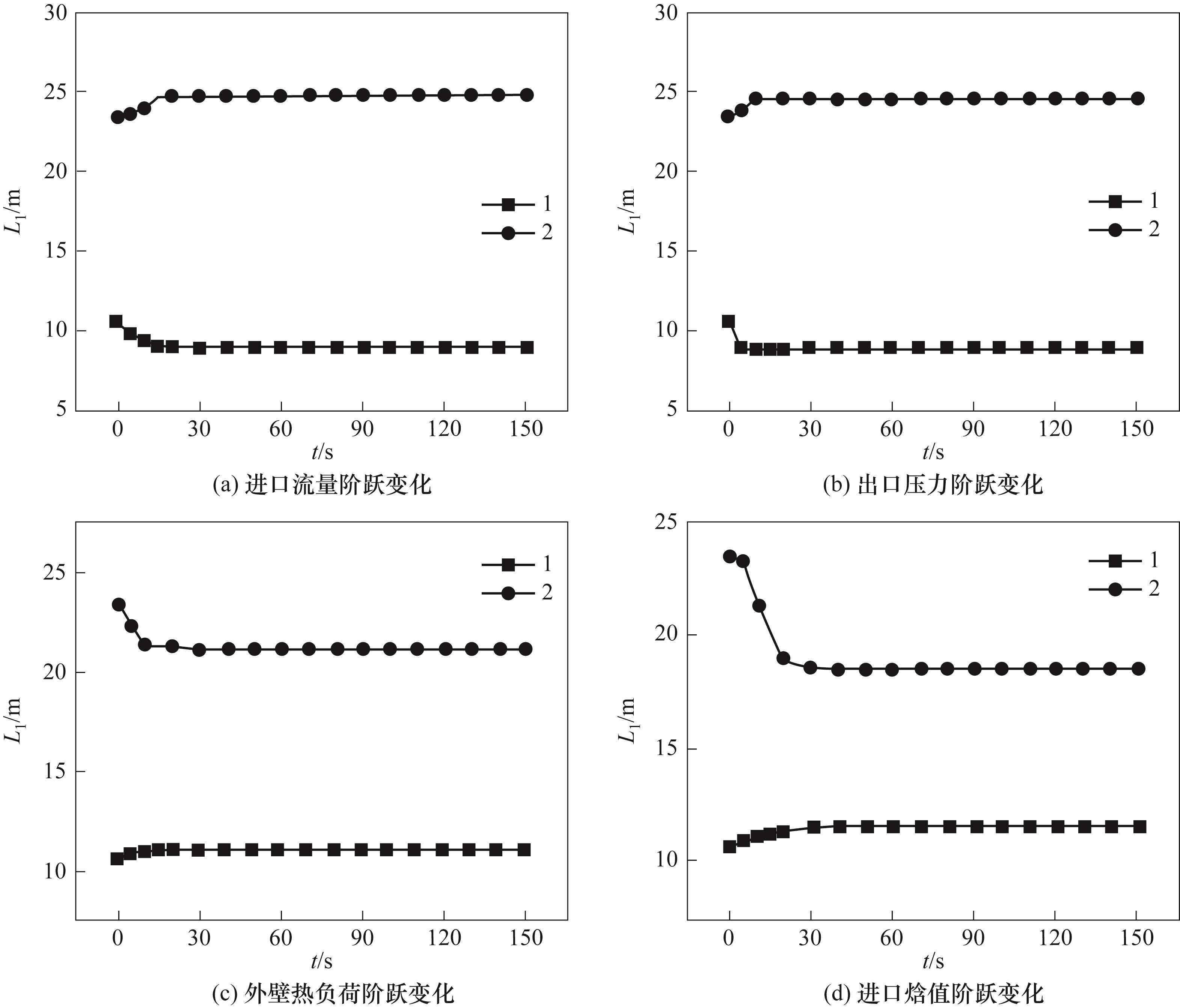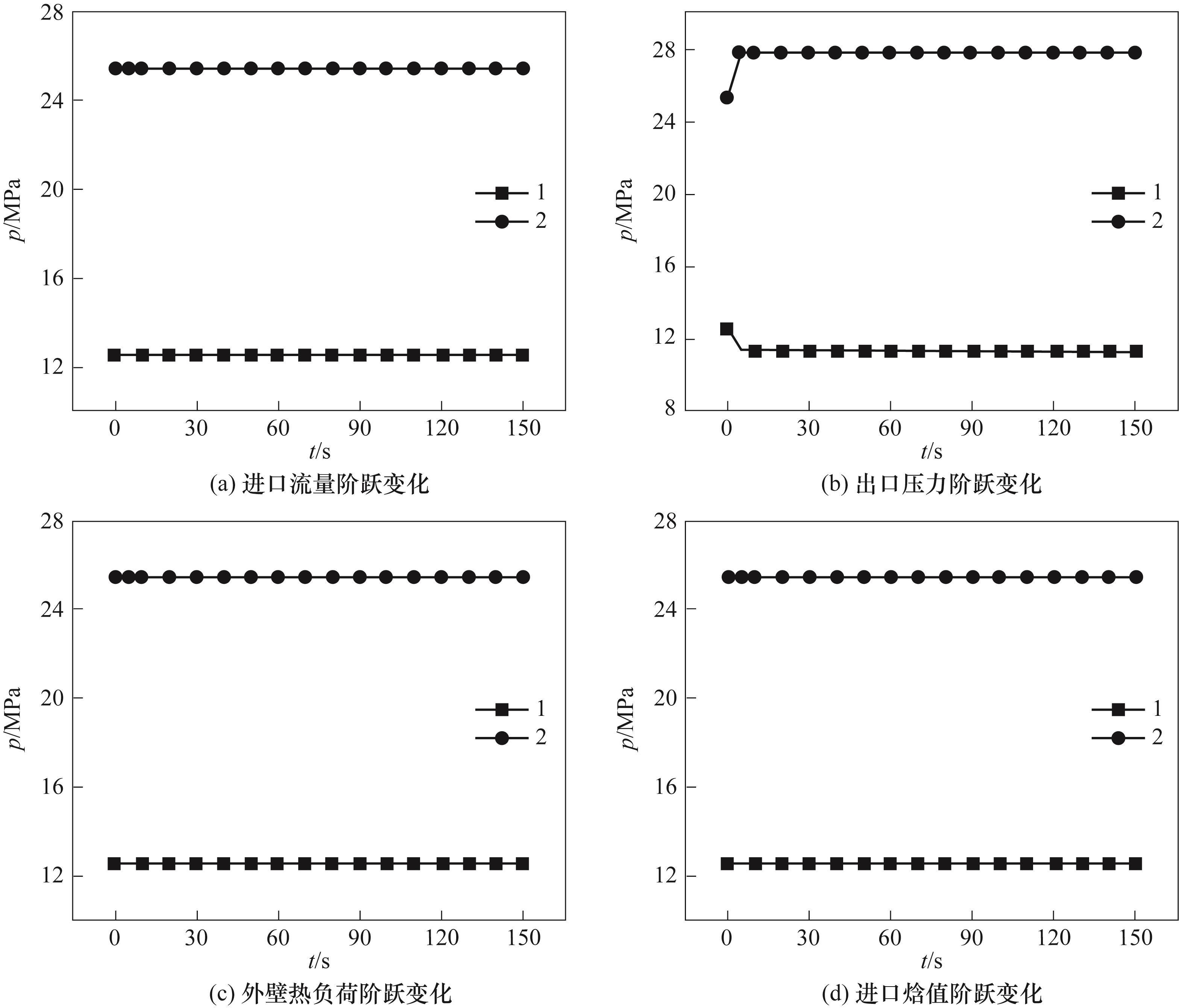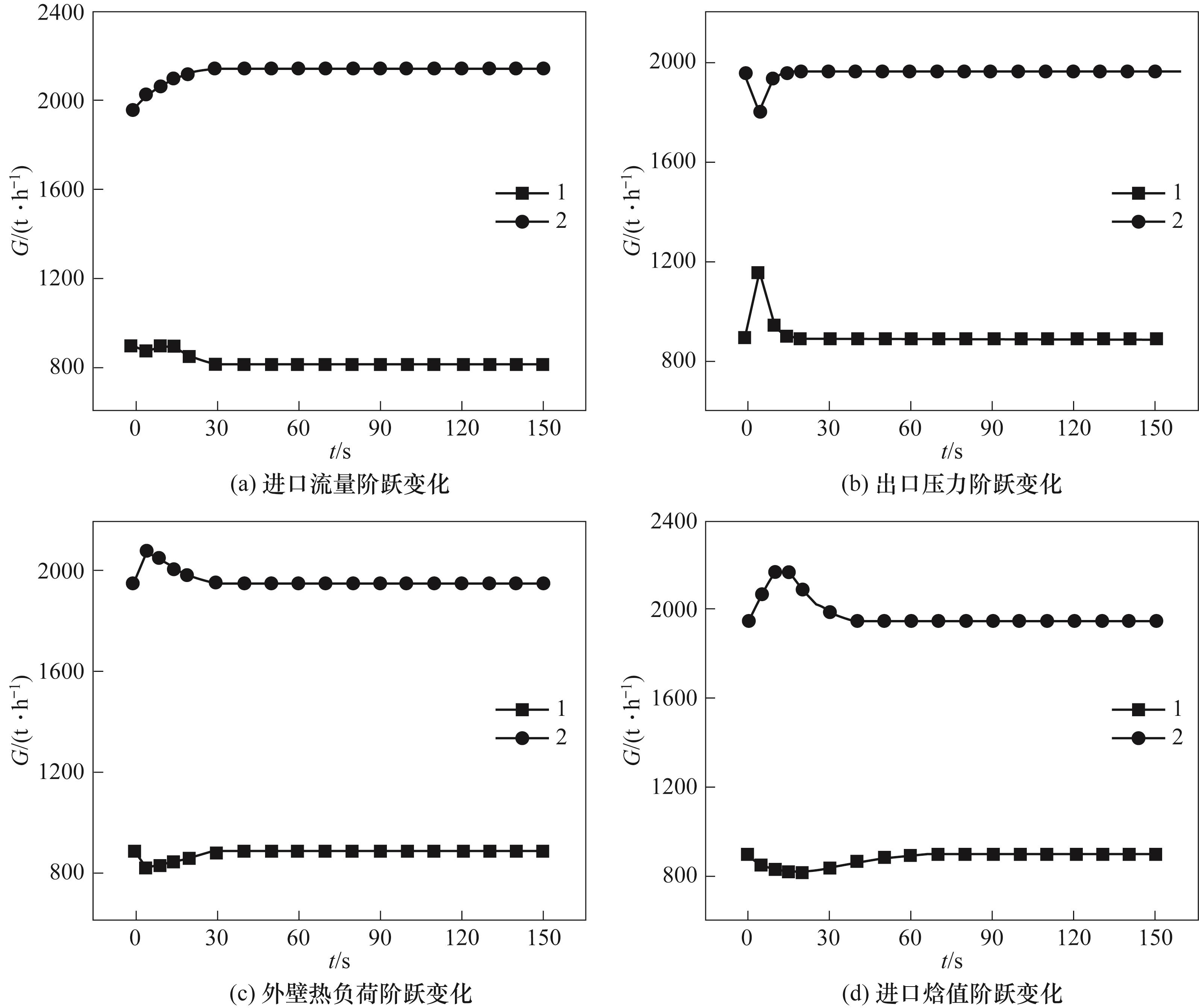化工学报 ›› 2025, Vol. 76 ›› Issue (6): 2638-2651.DOI: 10.11949/0438-1157.20241494
娄嘉诚1( ), 常福城2, 刘也铭1, 李志斌1, 李熙1, 李会雄1(
), 常福城2, 刘也铭1, 李志斌1, 李熙1, 李会雄1( )
)
收稿日期:2024-12-24
修回日期:2025-01-03
出版日期:2025-06-25
发布日期:2025-07-09
通讯作者:
李会雄
作者简介:娄嘉诚(2000—),男,博士研究生,3121103075@stu.xjtu.edu.cn
基金资助:
Jiacheng LOU1( ), Fucheng CHANG2, Yeming LIU1, Zhibin LI1, Xi LI1, Huixiong LI1(
), Fucheng CHANG2, Yeming LIU1, Zhibin LI1, Xi LI1, Huixiong LI1( )
)
Received:2024-12-24
Revised:2025-01-03
Online:2025-06-25
Published:2025-07-09
Contact:
Huixiong LI
摘要:
超超临界锅炉因其高效和低排放特性,在化工领域有着重要应用。水冷壁的瞬态响应特性对超临界机组的安全和高效运行至关重要。通过引入移动边界理论,提出了一种能够统一描述超临界锅炉水冷壁不同工质状态的移动边界模型。模型无须对各种工质状态分开进行建模与求解,一定程度上简化了计算。提出的网格移动方案可实现临界压力点的追踪,与以往采用静态近似的计算方法相比减小了误差,可更为简便、合理地解决各工质状态间的切换问题,继而实现全工况仿真。对1000 MW超超临界锅炉水冷壁的瞬态响应特性进行了动态仿真研究,通过与实验数据进行对比验证了模型的正确性和可靠性。结果表明,在扰动参数阶跃变化幅度相同时,出口压力阶跃变化后重新达到稳态所需的时间偏短,而进口焓值阶跃变化后重新达到稳态所需的时间偏长。在相同的输入扰动条件下,低负荷工况扰动后重新达到稳态所需时间较长,而高负荷时的过渡时间较短。
中图分类号:
娄嘉诚, 常福城, 刘也铭, 李志斌, 李熙, 李会雄. 1000 MW超超临界直流锅炉水冷壁瞬态响应特性的建模与仿真研究[J]. 化工学报, 2025, 76(6): 2638-2651.
Jiacheng LOU, Fucheng CHANG, Yeming LIU, Zhibin LI, Xi LI, Huixiong LI. Modeling and simulation study on transient response characteristics of water wall in 1000 MW ultra-supercritical once-through boiler[J]. CIESC Journal, 2025, 76(6): 2638-2651.
| 年份 | 作者 | 计算研究对象 | 使用的模型 | 模型的不足 |
|---|---|---|---|---|
| 1989 | 王广军等[ | HG-670/140锅炉 | 集总参数模型 | 无法实现全工况实时仿真 |
| 1993 | 吕子安等[ | 受热单管 | 集总参数模型 | 无法实现全工况实时仿真 |
| 2003 | 任挺进等[ | 某锅炉 | 链式结构集总参数模型 | 无法实现全工况实时仿真 |
| 2010 | 王志刚等[ | 600 MW超临界直流锅炉 | 集总参数模型 | 无法实现全工况实时仿真 |
| 2014 | 史一涛[ | 660 MW超临界直流锅炉 | 集总参数模型 | 模型不符合实际情况的假设偏多 |
| 1998 | 范永胜等[ | 600 MW超临界直流锅炉 | 移动边界模型 | 模型切换时采用静态近似法导致误差增大 |
| 2001 | 王伟等[ | 某超临界直流锅炉 | 移动边界模型 | 模型切换时采用静态近似法导致误差增大 |
| 2012 | 黄永和[ | 600 MW超临界直流锅炉 | 移动边界模型 | 模型切换时采用静态近似法导致误差增大 |
| 2014 | Hou等[ | 1000 MW超超临界直流锅炉 | 移动边界模型 | 模型只能计算出特定条件下热参数的主要趋势 |
| 2018 | 康英伟等[ | 660 MW超临界直流锅炉 | 移动边界模型 | 模型切换时采用静态近似法导致误差增大 |
表1 锅炉瞬态响应特性模型的研究现状汇总
Table 1 Summary of research status on transient response characteristics models of boilers
| 年份 | 作者 | 计算研究对象 | 使用的模型 | 模型的不足 |
|---|---|---|---|---|
| 1989 | 王广军等[ | HG-670/140锅炉 | 集总参数模型 | 无法实现全工况实时仿真 |
| 1993 | 吕子安等[ | 受热单管 | 集总参数模型 | 无法实现全工况实时仿真 |
| 2003 | 任挺进等[ | 某锅炉 | 链式结构集总参数模型 | 无法实现全工况实时仿真 |
| 2010 | 王志刚等[ | 600 MW超临界直流锅炉 | 集总参数模型 | 无法实现全工况实时仿真 |
| 2014 | 史一涛[ | 660 MW超临界直流锅炉 | 集总参数模型 | 模型不符合实际情况的假设偏多 |
| 1998 | 范永胜等[ | 600 MW超临界直流锅炉 | 移动边界模型 | 模型切换时采用静态近似法导致误差增大 |
| 2001 | 王伟等[ | 某超临界直流锅炉 | 移动边界模型 | 模型切换时采用静态近似法导致误差增大 |
| 2012 | 黄永和[ | 600 MW超临界直流锅炉 | 移动边界模型 | 模型切换时采用静态近似法导致误差增大 |
| 2014 | Hou等[ | 1000 MW超超临界直流锅炉 | 移动边界模型 | 模型只能计算出特定条件下热参数的主要趋势 |
| 2018 | 康英伟等[ | 660 MW超临界直流锅炉 | 移动边界模型 | 模型切换时采用静态近似法导致误差增大 |
| 负荷工况 | 工作压力/MPa | 质量流速/(t·h-1) | 进口温度/℃ |
|---|---|---|---|
| 100% BMCR | 27.62 | 2980 | 325 |
| 75% BMCR | 25.01 | 1953 | 297 |
| 30% BMCR | 12.29 | 885 | 266 |
表2 水冷壁运行参数
Table 2 Operating parameters of water-cooled wall
| 负荷工况 | 工作压力/MPa | 质量流速/(t·h-1) | 进口温度/℃ |
|---|---|---|---|
| 100% BMCR | 27.62 | 2980 | 325 |
| 75% BMCR | 25.01 | 1953 | 297 |
| 30% BMCR | 12.29 | 885 | 266 |

图6 30% BMCR负荷和75% BMCR负荷下扰动参数阶跃变化后热水段长度的响应过程
Fig.6 Response process of hot water section length after step change of disturbance parameters under 30% and 75% BMCR loads

图7 30% BMCR负荷和75% BMCR负荷下扰动参数阶跃变化后入口压力的响应过程
Fig.7 Response process of inlet pressure after step change of disturbance parameters under 30% and 75% BMCR loads

图8 30% BMCR负荷和75% BMCR负荷下扰动参数阶跃变化后出口流量的响应过程
Fig.8 Response process of outlet flow rate after step change of disturbance parameters under 30% and 75% BMCR loads

图9 30% BMCR负荷和75% BMCR负荷下扰动参数阶跃变化后出口工质焓值的响应过程
Fig.9 Response process of enthalpy value of outlet working fluid after step change of disturbance parameters under 30% and 75% BMCR loads

图10 30% BMCR负荷和75% BMCR负荷下扰动参数阶跃变化后出口工质温度与管壁温度的响应过程
Fig.10 Response process of outlet working fluid temperature and pipe wall temperature after step change of disturbance parameters under 30% and 75% BMCR loads
| [12] | Xu W T, Huang Y J, Song S H, et al. A new on-line combustion optimization approach for ultra-supercritical coal-fired boiler to improve boiler efficiency, reduce NO x emission and enhance operating safety[J]. Energy, 2023, 282: 128748. |
| [13] | Yang C, Zhang T, Sun L, et al. Piecewise affine model identification and predictive control for ultra-supercritical circulating fluidized bed boiler unit[J]. Computers & Chemical Engineering, 2023, 174: 108257. |
| [14] | 崔凝, 王兵树, 高建强, 等. 大容量余热锅炉动态模型的研究与应用[J]. 中国电机工程学报, 2006, 26(19): 103-109. |
| Cui N, Wang B S, Gao J Q, et al. Study and application on an dynamic model for the large capacity heat recovery steam generator[J]. Proceedings of the CSEE, 2006, 26(19): 103-109. | |
| [15] | 殷素芳, 王广军. 直流锅炉蒸汽发生器的模块化建模与仿真[J]. 计算机仿真, 2009, 26(4): 271-274. |
| Yin S F, Wang G J. Modular modeling and simulation of once-through boiler steam generator[J]. Computer Simulation, 2009, 26(4): 271-274. | |
| [16] | 王亚欧, 陶谦, 陈波, 等. 自然循环双压燃气轮机余热锅炉动态特性分析[J]. 中国电力, 2018, 51(2): 176-184. |
| Wang Y O, Tao Q, Chen B, et al. Dynamic characteristics analysis on a dual-pressure natural-circulation gas turbine heat recovery steam generator[J]. Electric Power, 2018, 51(2): 176-184. | |
| [17] | 章臣樾. 锅炉动态特性及其数学模型[M]. 北京: 水利电力出版社, 1987. |
| Zhang C Y. Dynamic Characteristics of Boiler and Its Mathematical Model[M]. Beijing: Water Resources and Electric Power Press, 1987. | |
| [18] | 王广军, 章臣樾. 锅炉动态过程能量方程的修正及受热面的当量金属质量[J]. 电力技术, 1989, 22(4): 1-3, 49. |
| Wang G J, Zhang C Y. Modification of energy equation of boiler dynamic process and equivalent metal mass of heating surface[J]. Electric Power, 1989, 22(4): 1-3, 49. | |
| [19] | 吕子安, 李天铎. 单相介质受热管集中参数模型建模方法的改进[J]. 系统仿真学报, 1993, 5(1): 1-8, 14. |
| Lyu Z A, Li T D. The improued lumped-parameter model of monophase fluid heated tubes[J]. Acta Simulata Systematica Sinica, 1993, 5(1): 1-8, 14. | |
| [20] | 任挺进, 谢茂清, 李志刚, 等. 锅炉单相受热面链式建模新方法[J]. 中国电机工程学报, 2003, 23(3): 175-178. |
| Ren T J, Xie M Q, Li Z G, et al. A new method of chain structure medeling on boiler's single-phase heat-exchanger[J]. Proceedings of the CSEE, 2003, 23(3): 175-178. | |
| [21] | 王志刚, 雷兆团, 张广才. 超临界600 MW机组直流锅炉动态特性研究[J]. 热力发电, 2010, 39(9): 14-20. |
| Wang Z G, Lei Z T, Zhang G C. Study on dynamic behavior of once-through boiler euipped for supercritical 600 MW unit[J]. Thermal Power Generation, 2010, 39(9): 14-20. | |
| [22] | 史一涛. 660 MW超临界直流机组动态特性仿真研究[D]. 北京: 华北电力大学, 2014. |
| Shi Y T. Simulation study on dynamic characteristics of 660 MW supercritical DC unit[D]. Beijing: North China Electric Power University, 2014. | |
| [23] | 范永胜, 徐治皋, 陈来九. 超临界直流锅炉蒸汽发生器的建模与仿真研究(一)[J]. 中国电机工程学报, 1998, 18(4): 246-253. |
| Fan Y S, Xu Z G, Chen L J. Modeling and simulation of steam generator in supercritical once-through boiler (1)[J]. Proceedings of the CSEE, 1998, 18(4): 246-253. | |
| [24] | 王伟, 任挺进, 高琪瑞, 等. 直流锅炉蒸发区域的数学模型及其仿真[J]. 清华大学学报(自然科学版), 2001, 41(10): 105-108. |
| Wang W, Ren T J, Gao Q R, et al. Mathematical model and simulation of the evaporating surface in a once-through boiler[J]. Journal of Tsinghua University (Science and Technology), 2001, 41(10): 105-108. | |
| [25] | 黄永和. 600 MW超临界直流锅炉水冷壁系统建模与仿真[D]. 重庆: 重庆大学, 2012. |
| [1] | Deng B Y, Zhang M, Wei G H, et al. Analysis and referential significance of a breakdown accident of the main feed water pump in a 350 MW supercritical CFB boiler[J]. Journal of Thermal Science, 2023, 32(5): 1797-1806. |
| [2] | Du J J, Li Y L, Zhao Y G, et al. Numerical study of supercritical opposed wall-fired boiler furnace temperature and high-temperature heating surface stress under variable load operation[J]. Energies, 2024, 17(3): 663. |
| [3] | Du X C, Song Y Y, Xiang Y X, et al. Numerical investigation on the heat transfer characteristics of supercritical water in a non-uniformly heated tube for a supercritical CFB boiler[J]. Journal of Thermal Science, 2023, 32(5): 1807-1818. |
| [4] | Liu K R, Wang C, Wang L M, et al. Dynamic performance analysis and control strategy optimization for supercritical coal-fired boiler: a dynamic simulation[J]. Energy, 2023, 282: 128712. |
| [5] | 李炳楠, 朱峰, 燕志伟, 等. 超临界火电机组协调系统建模及模型预测控制算法研究[J]. 热能动力工程, 2020, 35(2): 117-125. |
| Li B N, Zhu F, Yan Z W, et al. Research on modeling and model predictive control algorithm for supercritical thermal power unit coordination system[J]. Journal of Engineering for Thermal Energy and Power, 2020, 35(2): 117-125. | |
| [6] | 陈听宽. 超临界与超超临界锅炉技术的发展与研究[J]. 世界科技研究与发展, 2005, 27(6): 42-48. |
| Chen T K. Development and research on supercritical and ultra-supercritical boiler technology[J]. World Sci-tech R & D, 2005, 27(6): 42-48. | |
| [7] | 吴鹏举, 朱超, 万李, 等. 超临界机组锅炉20%负荷深度调峰水动力实炉试验研究[J]. 热力发电, 2021, 50(4): 59-66. |
| Wu P J, Zhu C, Wan L, et al. Actual furnace test research on hydrodynamics of a supercritical boiler at 20% deep peak load[J]. Thermal Power Generation, 2021, 50(4): 59-66. | |
| [8] | 赵子东, 阎维平. 超临界蒸汽参数卧式余热锅炉概念设计与分析[J]. 动力工程学报, 2018, 38(7): 513-518, 530. |
| Zhao Z D, Yan W P. Conceptual design and thermal analysis of a horizontal HRSG under supercritical steam conditions[J]. Journal of Chinese Society of Power Engineering, 2018, 38(7): 513-518, 530. | |
| [9] | 陈听宽. 超临界锅炉技术的发展[J]. 电力设备, 2002(3): 19-24. |
| Chen T K. Development of supercritical boiler technology[J]. Electrical Equipment, 2002(3): 19-24. | |
| [10] | Wang X S, Yang C, Zhang Z L. Online tracking simulation system of a 660 MW ultra-supercritical circulating fluidized bed boiler[J]. Journal of Thermal Science, 2023, 32(5): 1819-1831. |
| [11] | Wang Z, Yao G J, Xue W Y, et al. A data-driven approach for the ultra-supercritical boiler combustion optimization considering ambient temperature variation: a case study in China[J]. Processes, 2023, 11(10): 2889. |
| [25] | Huang Y H. Modeling and simulation of water cooling system for 600 MW supercritical once-through boiler[D]. Chongqing: Chongqing University, 2012. |
| [26] | Hou G L, Huang F R, Sun T Y, et al. Mathematical model for ultra-supercritical unit by physical principles[C]//2014 9th IEEE Conference on Industrial Electronics and Applications. Hangzhou, China: IEEE, 2014: 781-786. |
| [27] | 康英伟, 李月, 郑鹏远, 等. 660 MW超超临界直流锅炉水冷壁系统动态特性仿真[J]. 热能动力工程, 2018, 33(10): 52-59. |
| Kang Y W, Li Y, Zheng P Y, et al. Dynamic characteristics simulation of the water wall system of a 660 MW ultra-supercritical one-through boiler[J]. Journal of Engineering for Thermal Energy and Power, 2018, 33(10): 52-59. | |
| [28] | Ma X F, Jiang P X, Zhu Y H. Dynamic simulation model with virtual interfaces of supercritical working fluid heat exchanger based on moving boundary method[J]. Energy, 2022, 254: 124334. |
| [29] | Giovannini M, Lorenzini M. Switching criteria analysis for a condenser moving boundary model[J]. Journal of Physics: Conference Series, 2024, 2685(1): 012040. |
| [30] | Bürger R, Careaga J, Diehl S, et al. A moving-boundary model of reactive settling in wastewater treatment(Part 2): Numerical scheme[J]. Applied Mathematical Modelling, 2022, 111: 247-269. |
| [31] | Jiao X R, Jiang S, Liu H. Nonlinear moving boundary model of low-permeability reservoir[J]. Energies, 2021, 14(24): 8445. |
| [32] | Šulc S, Šmilauer V, Wald F. Thermal model for timber fire exposure with moving boundary[J]. Materials, 2021, 14(3): 574. |
| [33] | van der Velden T, Ritzert S, Reese S, et al. Modeling the moving boundary value problem of electrochemical machining[J]. PAMM, 2023, 22(1): e202200147. |
| [34] | 王宗琪, 王陶, 王建蒙, 等. 直流锅炉蒸发区域一种新的建模方法[J]. 系统仿真学报, 1998, 10(2): 19-24. |
| Wang Z Q, Wang T, Wang J M, et al. A new method for modeling evaporation zone of once through boiler[J]. Journal of System Simulation, 1998, 10(2): 19-24. | |
| [35] | 解衡, 张金玲, 贾斗南, 等. 直管式直流蒸汽发生器的热工水力特性分析与计算[J]. 核科学与工程, 1997, 17(2): 97-102. |
| Xie H, Zhang J L, Jia D N, et al. Analysis and calculation of thermal and hydraulic characteristics of straight tube once-through steam generator[J]. Nuclear Science and Engineering, 1997, 17(2): 97-102. | |
| [36] | Wang H, Bi Q C, Wu G, et al. Experimental investigation on pressure drop of supercritical water in an annular channel[J]. The Journal of Supercritical Fluids, 2018, 131: 47-57. |
| [37] | 陶文铨. 数值传热学[M]. 2版. 西安: 西安交通大学出版社, 2001. |
| Tao W Q. Numerical Heat Transfer[M]. 2nd ed. Xi'an: Xi'an Jiaotong University Press, 2001. | |
| [38] | 黄锦涛. 600 MW超临界直接锅炉螺旋管圈水冷壁动态过程特性及敏感性研究[D]. 西安: 西安交通大学, 1999. |
| Huang J T. Study on dynamic process characteristics and sensitivity of spiral coil water wall of 600 MW supercritical direct boiler[D]. Xi'an: Xi'an Jiaotong University, 1999. |
| [1] | 密晓光, 孙国刚, 程昊, 张晓慧. 印刷电路板式天然气冷却器性能仿真模型和验证[J]. 化工学报, 2025, 76(S1): 426-434. |
| [2] | 黄灏, 王文, 李沛昀. 三角转子膨胀机串联运行特性研究[J]. 化工学报, 2025, 76(S1): 435-443. |
| [3] | 张文锋, 郭玮, 张新玉, 曹昊敏, 丁国良. 铝管铝翅片换热器模型开发及软件实现[J]. 化工学报, 2025, 76(S1): 84-92. |
| [4] | 郭纪超, 徐肖肖, 孙云龙. 基于植物工厂中的CO2浓度气流模拟及优化研究[J]. 化工学报, 2025, 76(S1): 237-245. |
| [5] | 马爱华, 赵帅, 王林, 常明慧. 太阳能吸收制冷循环动态特性仿真方法研究[J]. 化工学报, 2025, 76(S1): 318-325. |
| [6] | 吴成云, 孙浩然. 民用飞机空调系统性能仿真与燃油代偿损失研究[J]. 化工学报, 2025, 76(S1): 351-359. |
| [7] | 李卫, 陈浩, 柯钢, 黄孝胜, 李成娇, 郭航, 叶芳. 高原环境适应性试验室模拟平台新风系统仿真[J]. 化工学报, 2025, 76(S1): 360-369. |
| [8] | 肖鑫, 杨耿, 王云峰. 基于TRNSYS的太阳能梯级蓄热热泵系统模拟[J]. 化工学报, 2025, 76(S1): 393-400. |
| [9] | 刘豪, 王林, 丁昊, 耿嘉怡. R1150+R1234ze(E)二元体系223.15~253.15 K汽液相平衡研究[J]. 化工学报, 2025, 76(S1): 1-8. |
| [10] | 张豪豪, 郭莉, 李馨怡, 陈锦溢, 华超, 陆平. 隔板精馏塔的优化设计及动态控制研究进展[J]. 化工学报, 2025, 76(6): 2434-2450. |
| [11] | 李文亮, 纪成, 梁晨, 吴思辰, 陈石林, 孙巍, 翟持. 基于TDMN的青霉素浓度在线软测量[J]. 化工学报, 2025, 76(6): 2848-2858. |
| [12] | 祝丽娜, 苗茂栋, 金赛, 赵忠盖, 孙福新, 石贵阳, 刘飞. 柠檬酸三钙中和过程的强化学习优化控制[J]. 化工学报, 2025, 76(6): 2838-2847. |
| [13] | 张亿韵, 陈恒志, 李洋, 慕长安, 王泉海. 湍流对双组分颗粒流化床气体径向扩散的影响[J]. 化工学报, 2025, 76(6): 2559-2568. |
| [14] | 熊敏, 刘冬妹, 王智超, 周利, 吉旭. 变负荷条件下绿氨生产操作参数的调控与优化[J]. 化工学报, 2025, 76(6): 2791-2801. |
| [15] | 李家顺, 李旺, 秦祖赠, 苏通明, 谢新玲, 纪红兵. 聚酰亚胺增强木质纤维素纳米纤丝气凝胶制备及其油水分离性能研究[J]. 化工学报, 2025, 76(5): 2169-2185. |
| 阅读次数 | ||||||
|
全文 |
|
|||||
|
摘要 |
|
|||||
 京公网安备 11010102001995号
京公网安备 11010102001995号